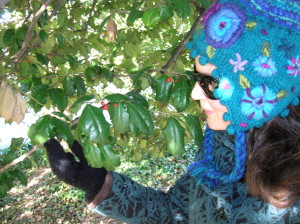Are you getting ready for math finals… maybe even your first math final ever? Are you uncertain how to study and prepare?
Or, if you’re a parent, not a student, does the thought of getting through your kid’s math final fill you with dread?
This week, since I’m right in the middle of preparing several of my students for their final math exams, I want to share all my best math studying tips with you – whether you’re a student or a parent – so you can happily survive finals week with a minimum of stress.
This is the exact same process I walk my students through, and also the exact same powerful tips I share with my private clients!
And I’m not just going to share my own tips – I’m also going to share some of my students’ tips, too!
First, just some basic overall tips about the big picture of taking your math final, especially if it’s your first one:
1. Breathe. If thinking about your math final, or your kid’s math final, sends you into a panic, keep breathing. Just keep breathing deeply. If you forget, you can start again right now. Take a deep breath. Right now. You can do this. Take three deep breaths. Yes. That’s right!
2. Eat. Make sure that you’re getting really good meals all throughout finals week. You want to keep nourishing your brain with high quality protein! Also, you will be less stressed, more receptive when studying, and find it easier to retain what you’re learning when your blood sugar isn’t careening all over the place.
If you’re the parent, making sure you get good nutrition this week is also important and will make it easier to be calm and loving with your kid if they need help from you.
3. Sleep. I know! It is important to get good sleep all through finals week – not just the night before the test! (Even if you’re the parent!) You will get WAY more out of your study sessions if you are getting good sleep every night. And actually, if you have to choose between studying and sleeping, you’ll get higher grades if you choose to sleep. (Counterintuitive but true!)
Just doing those three simple things alone will help. Now let me share with you the exact play-by-play study plan one of my star students and I just created.
Before finals week…
1. At least a week before finals week, make a study plan for the entire week.
2. Pace yourself. Be realistic about how much studying you can get done each day of finals week. If you have another final the next morning, it probably isn’t going to be a big math study day, and that’s OK.
3. Break it up. If you have a big review packet due for homework, don’t plan on doing it all in one giant lump. Doing three math packets all in one afternoon is probably not the best plan.
4. Make sure to build in some wiggle room. That way if you don’t get all of your study packets done as planned, you still have time to get it done before your math final and before your study packet is due.
5. Expect to have questions, and plan accordingly. As part of your overall study plan, expect that there will be some problems, topics, or concepts you’ll want to get outside help with.
Factor this into your study schedule so at the latest, two days before the test, you can turn to your parents, teacher, or trusted math-savvy friends to get your questions answered. Then the day before you can just focus on reviewing what you’ve already clarified.
When you start studying…
6. If you really need to prioritize your studying time, when you start going through your study packet, look for the hard, confusing, unfamiliar problems and try to work on them first. That way you’ll know what you have questions about as soon as possible. If this freaks you out, don’t worry, that’s okay. Just back up and do easier problems that are related to that topic to build up to the harder problems.
7. When you get to a problem you don’t remember how to do, make an easy, simplified version of the problem. A lot of times this is all it takes to remember exactly what to do.
For example, let’s say you need to convert 5.6% from a percent to a decimal. You might think, “OMG, I have no idea what to do, how can I convert it to a decimal when it already has a decimal in it…??!!” First, make a simpler version of the same problem. Just say you need to convert 5% from a percent to a decimal. Ok, now you remember you just need to move the decimal point two spaces to the left, so it will be .05. Great! Now it’s easier to see that with 5.6%, you also just need to move the deciaml point two spaces to the left, so it would be .056. Now we’re back on track! (And by the way, this is what professional mathematicians do when they get stuck.
8. As you go through your study packets, make a list of the equations you need to have memorized for your math exam. Practice writing them down from memory so by the day of your math final they are no big deal.
9. Plan to take breaks. And then actually take breaks. This will help you remember things better, keep you from getting too stressed out, and also makes the whole process more enjoyable. Take breaks that rest your eyes (from all that reading), your neck (from having it at that “reading angle”), and your brain (from thinking so hard). Pay attention to what actually helps you feel refreshed – maybe walking around the block or taking a dance break will replenish you more than checking facebook, for example.
The countdown to the final…
10. The day before the test, plan on reviewing what you’ve already practiced and understand.
11. Be sure to do something fun and relaxing the night before the exam, like watching one of your favorite movies or listening to your favorite music.
12. If this would help you feel super prepared, pack your bag with everything you need so you won’t need to worry about it the morning of the test.
13. Get a good night’s sleep the night before. (This probably the most important thing you could do of all!)
14. The morning of your test, be sure to get a good breakfast with lots of protein.
15. A great tip from one of my very successful students: On your way to school, don’t study in the car. At this point, you really either know it or you don’t. Just listen to some of your favorite relaxing music, for example.
16. Be sure to get to the location of your math final early so you’re not worried about being late.
During the final…
17. Another tip from one of my successful students: When you get your math final, close your eyes, take three deep breaths, and then open your eyes to begin. This will help you focus.
18. Write down all of the equations you need to know at the top of the page before you even look at any of the problems. That way you won’t need to worry about keeping them in your brain while you’re going through the test. It will be way more relaxing knowing they’re already written down and right there for you.
19. Once you start going through the test, make sure to do the easy problems first.
20. No one problem is worth a lot of your time or worth freaking out over. So if you find yourself getting really bogged down, stop, mark the problem so you know to come back to it later, and move on. You can always come back to it later after you’ve gotten the easier points first.
21. If you come to a problem where you don’t know what to do:
-take a deep breath and read it again (this tip directly comes from one of my students)
-if you’re not sure what to do, mark it and come back to it later
-when you come back to it later, experiment with creating an easy version to see if that reminds you how to do it (like you did while you were studying)
-a tip from one of my students: sit in silence with your eyes closed, take a few deep breaths, and go through your mental math files to see if you get any ideas.
22. If other kids are finishing earlier than you, don’t worry. Just because someone turns in their exam before you do doesn’t mean that they actually got the problems right. (Not that we would want this to happen to anyone, but they might be turning it in quickly because they gave up and didn’t finish!)
23. Throughout the entire exam, remember, it’s just an exam. If you get a point off, it’s not the end of the world. (This is an exact quote from one of my students!)
After the math final, when you’re still at school…
24. Remember, right after the final is over, it’s up to you whether or not you want to discuss the test with your classmates. If that is helpful to you, go for it! If it makes you stressed, or you just like to keep your experience private, you don’t have to talk about it with anyone!
25. If you do talk with other students about what answers you got, don’t worry if they got a different answer than you. Just because they got a different answer doesn’t mean that they’re right!
After you leave the school building…
26. If you’re the parent: don’t ask your kid “How was your math final?” We’re socially conditioned to say, “fine,” “good,” or “great.” This isn’t actually very informative. And it doesn’t encourage the student to reflect.
You’ll get a lot more information out of your kid – and encourage them to analyze their experience – if you ask, “What was your math final like?” Then they can share the experience with you more fully without it being about “I did great” or “I did horribly.”
27. Be sure to celebrate! Give your parents a hug, have a dance party in your room, eat some ice cream, sing your favorite song, or just do whatever feels like a celebration to you. You just finished your math final!! YAY!! Party time!!
28. When you get your test results back, focus on learning from your experience. If you did amazing, what did you do to create that awesome result? Be super specific with yourself about what worked so you can do it again next time and get great results again! If your results aren’t what you wanted, expected, or hoped for, what could you do differently in the future?
If you want next year’s math finals to be a way better experience for your entire family, and you’re ready to receive high-level, exclusive one-on-one support that is not typical tutoring, I would love to talk to you.
To get started with your special application for my one-on-one math tutoring programs, just click here.
Sending you love,
REBECCA
Related posts:
How to get started when you have no idea what to do
When doing your math homework just isn’t cutting it
What to do when you get a disappointing math test grade
How to experience math as your own unique creation









